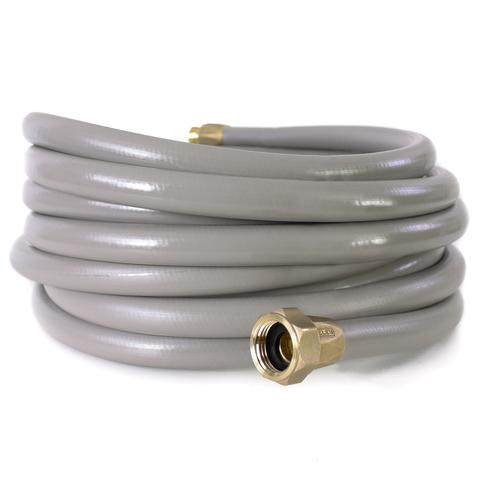Polyurethane Garden Hose vs. Rubber Garden Hose
The right hose for you depends on your needs and personal preferences. In a nutshell, here are the primary differences:
Weight - The rubber hose weighs twice as much as the polyurethane hose. This is most noticeable while pulling the hose out and reeling it back in.
Durability - The outer cover on the polyurethane hose is made of the same material as the wheels on in-line roller skates. It is the most durable covering we have ever found. This will be important if the hose is pulled across rough or sharp surfaces, such as rock, or if pulled around stone corners, etc. The outer cover on the rubber hose is softer and easier to tear.
Flexibility - The rubber hose is a softer and more flexible material than the polyurethane. The rubber hose will wrap back onto the hose reel very uniformly for a nice 'look'. The polyurethane hose is more of a rubbery material. It has a certain amount of spring or bounce to it. This is an advantage when it comes to kink-resistance, (which is discussed below), but not so much when it comes to creating a nice smooth wrap on the hose. The poly hose can roll up quickly and easily onto a hose reel, however, a picture-perfect looking wrap is not as easily attained as it is with the rubber hose. Also, the longer lengths of polyurethane hose should only be used with a hose reel. Trying to loop a poly hose into a circular coil on the ground will be an exercise in frustration. Both hoses remain extremely flexible, even in cold temps.
Kink-Resistance - The rubber hose is much more likely to kink, like traditional garden hoses, and also retain a 'kink memory', which is what happens when a hose seems to remember where it kinked, and then has a tendency to more easily kink over and over again in that same spot. The positive side of the rubbery nature of polyurethane hose, is that it has a tendency to 'flip' out of a kink rather than collapse down into one. Plus, the polyurethane has zero kink memory.
Fittings – The Eley polyurethane hose comes equipped with lead-free, crush-proof brass fittings, while the brass fittings on most rubber hoses are not lead-free. Lead-free means the ELEY polyurethane hoses are drinking-water-safe. ELEY fittings also provide a true 5/8-inch opening for full-flow. While the ID of rubber hoses may be 5/8-inch, the external crimp fittings typically have openings much smaller and therefore reduce the flow-rate.
Size/Storage Capacity - Although both hoses provide the same 5/8" ID of water flow, the cover on the rubber hose is much thicker, which is one contributing reason for the additional weight. The thicker covering also means you can't store as much of the rubber hose on the hose reel. The maximum capacity of our standard reels with the 5/8" polyurethane hose is 125 feet. The maximum capacity with 5/8" of rubber hose is only 100 feet. With the Extra-Capacity Kit, these capacities are 200 feet and 150 feet respectively.
Pressure Rating - Both the polyurethane hose and most rubber hose are rated at 150 PSI.
Temperature Rating - The polyurethane hose is rated at -40°F to 165°F. The rubber hose is rated at -40°F to 190°F.
Non-Marking - The polyurethane cover is 100% non-marking, meaning you don’t have to worry about it leaving marks across clean surfaces. The rubber hose is a softer material and can occasionally leave marks on surfaces or a small black residue on your hands after reeling the hose in.
Warranty - It's difficult to find a warranty period advertised for most garden hoses sold today. Not so with ELEY. Both our warranties are better than virtually any other hose on the market. Our polyurethane hose is warrantied for 10 years, primarily because of the durability of the material.
Drinking-Water Safe - ELEY polyurethane garden hoses are "Drinking Water Safe". The Rubber hose is not.
























































